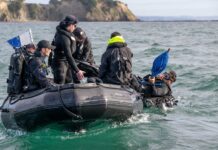
Biosecurity New Zealand is taking into account reports of a potential reduction of caulerpa in some areas before it decides whether to issue a controlled area notice which would restrict anchoring at Onetangi.
The agency’s pest management director John Walsh says since a public meeting was held at Onetangi Hall in October, it has received several reports of potential caulerpa dieback around Waiheke and Aotea Great Barrier Island.
“We’ve had NIWA investigating this over the last couple of weeks,” he says. “The team surveyed the waters around Thompsons Point and Onetangi Bay at Waiheke, and Okupu Blind Bay, Tryphena Harbour and Schooner Bay at Aotea.”
“Preliminary results show there has been a significant reduction in caulerpa in areas of sandy or soft sediment seabed at Onetangi Bay, but it remains more apparent at Thompson’s Point on rocky reef,” he continues. “At Aotea, there has been significant dieback at Okupu Blind Bay, but it is less pronounced at Tryphena and Schooner Bay, and in some places it has increased.”
• Tessa King
Full story in this week’s Gulf News……. On sale now
© Waiheke Gulf News Ltd 2024






